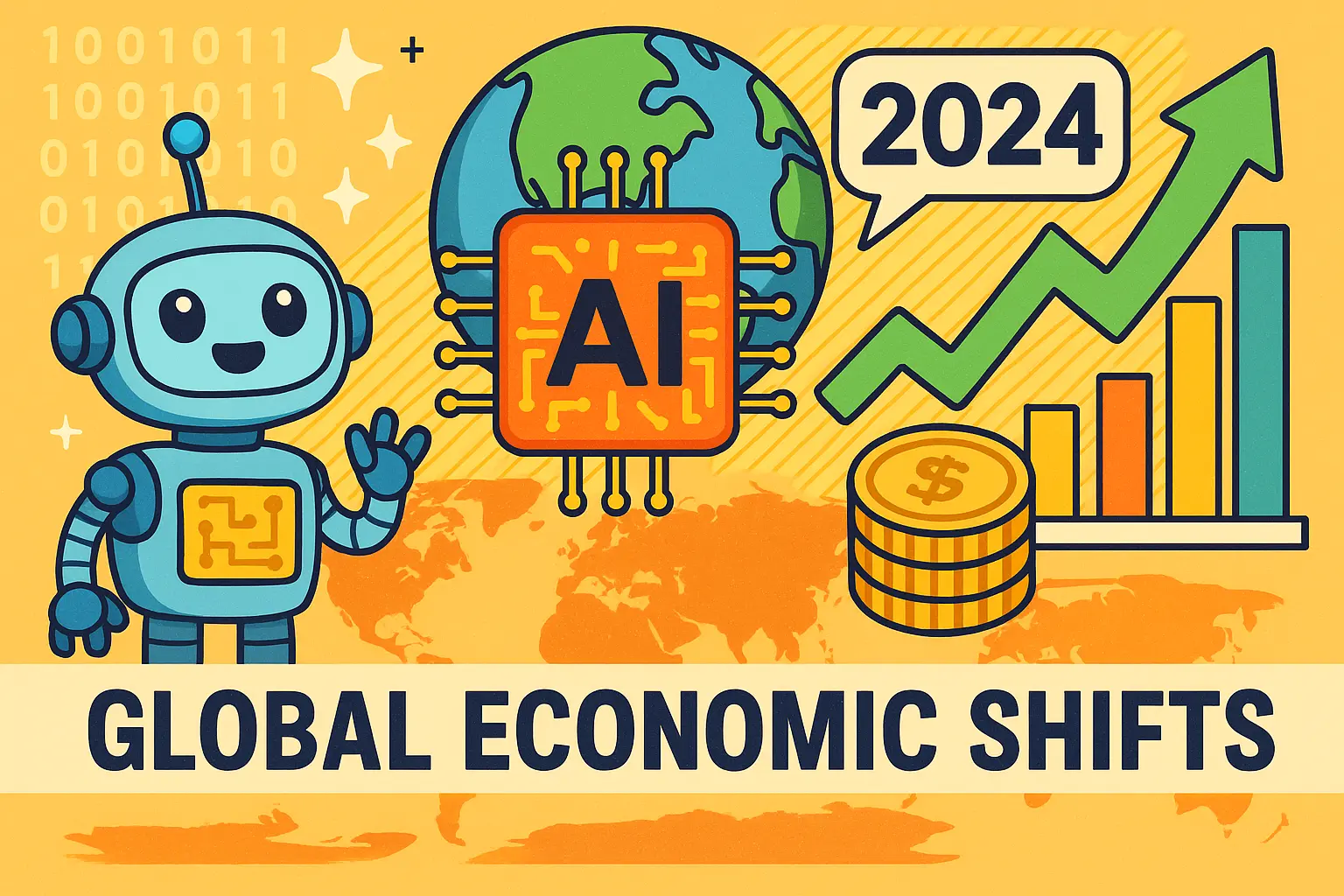The global economic shifts 2024 narrative is being written in real time as markets, governments, and industries navigate an intricate blend of technological innovation, geopolitical maneuvering, and shifting monetary policies.
From China’s slowdown and a potential U.S. government stake in Intel, to Japan’s unexpected GDP growth and the rising dominance of AI and semiconductor sectors, the world’s financial and political landscape is undergoing rapid change. Add in the high-stakes Trump-Putin summit and shifting Federal Reserve policy expectations, and it’s clear that investors, policymakers, and everyday citizens alike face an environment where adaptability is essential.
This deep-dive explores the most critical developments shaping markets in 2024, what they mean for the future, and how different regions are positioning themselves in an increasingly interconnected — and volatile — global economy.
China’s Economic Headwinds: Structural Slowdown and Policy Challenges
China’s latest economic data shows a decisive slowdown. Industrial output, retail sales, and property investment are all under pressure, affected by extreme weather events and government-imposed capacity cuts aimed at reducing overproduction.
The Property Market Crisis
Beijing is reportedly considering a significant intervention: using state-owned enterprises to purchase unsold housing stock. This would be a bold attempt to tackle the property glut that has been dragging on growth for years. While such measures could provide a short-term boost, they also highlight the depth of the crisis — and the limits of conventional policy tools.
Consumption subsidies, particularly in consumer electronics, have offered some relief, but they are unlikely to reverse the broader slowdown. This reflects a structural challenge: China must balance short-term growth with long-term reforms, while also navigating tensions with key trading partners.
For more on how changing economies are impacting hiring patterns, see our analysis: Hiring Manager Expectation 2025: What Top Employers Want This Year.
U.S. Industrial Policy Shift: Government Stake in Intel
In a potential paradigm shift for U.S. industrial policy, the Trump administration is reportedly considering acquiring a stake in semiconductor giant Intel. This would mark a rare instance of direct government involvement in a major technology company — especially one crucial to national security and supply chain resilience.
Why It Matters
Intel’s planned Ohio manufacturing plant has faced delays, raising concerns about America’s competitiveness in semiconductor production amid rising tensions with China. A government stake could accelerate the project, but it also raises political and corporate governance questions, particularly from those wary of government influence in private enterprise.
Such a move would represent a strategic departure from traditional Republican free-market principles, aligning more with industrial policy playbooks seen in countries like South Korea and Japan. It would also echo past interventions like the 2008 auto industry rescue, albeit in a far more technologically strategic sector.
Fed Policy Uncertainty: Inflation Keeps Markets Guessing
The Producer Price Index (PPI) in the U.S. came in hotter than expected, largely due to rising service-sector costs. This has led to a reassessment of expectations for Federal Reserve interest rate cuts, with September still likely for easing — but with far less certainty.
Balancing Act
The Federal Reserve’s cautious stance reflects a data-dependent approach. Persistent inflation, possibly worsened by tariffs, is making it harder for the Fed to cut rates without risking another inflationary surge. For markets, this means volatility is here to stay, with bond yields rising and investor sentiment swinging sharply on each new data release.
Trump-Putin Summit in Alaska: Geopolitical High Stakes
The upcoming Trump-Putin summit in Alaska is expected to address issues ranging from Ukraine and arms control to broader economic cooperation. The optics are significant: Putin has signaled a willingness to engage diplomatically, even praising Trump’s leadership style, while the U.S. hopes to position the talks as a step toward a larger peace dialogue involving Ukraine and European leaders.
Risks and Opportunities
The potential for breakthroughs exists, but so does the risk of stalemate. Territorial disputes, sanctions, and competing geopolitical priorities could derail progress. Any agreement (or failure) will ripple through energy markets, defense industries, and diplomatic alliances.
Japan’s Surprise GDP Growth Boosts Market Sentiment
Japan surprised economists with a 1% GDP growth in Q2, significantly beating expectations. The result has bolstered domestic equity markets and strengthened the yen, prompting speculation about the Bank of Japan’s next policy moves.
Political Context
The positive data comes amid uncertainty over Prime Minister Kishida’s leadership and the ruling party’s political stability. While strong growth may reduce immediate pressure for policy changes, it also leaves open the possibility of rate hikes later in the year, which could impact both domestic and international markets.
Build a Future-Ready Workforce
Post your job on WhatJobs and connect with adaptable, skilled professionals ready to thrive amid global change.
Post a Job Now →New Zealand’s Trade Diplomacy Amid Tariffs
New Zealand’s government is reaffirming its commitment to U.S. trade relations, even as tariffs remain a point of contention. At the same time, the country is diversifying trade partnerships with the EU, UK, GCC, and India to reduce dependence on any single market.
Strategic Balancing
This pragmatic approach is a case study in how smaller economies can maintain stability in an era of U.S.-China trade tensions. By spreading risk across multiple trade agreements, New Zealand is better positioned to weather geopolitical shocks.
AI and Semiconductor Sectors: The Growth Engines of 2024
Investors are increasingly directing capital toward AI infrastructure and semiconductor manufacturing, both of which are critical to the next wave of global technological innovation.
Corporate Earnings Strength
Tech giants reporting strong earnings are fueling optimism, but the monetization of AI remains in early stages. The interplay between AI’s rapid adoption and the hardware required to support it — particularly chips and data centers — is creating opportunities for both established players and emerging startups.
Investor Sentiment and Risk Management
While certain sectors are booming, markets remain vulnerable to shocks — whether from unexpected inflation data, Fed policy shifts, or geopolitical escalations. With valuations at historic highs in some markets, selective exposure and sector rotation strategies are becoming increasingly important.
Defensive plays in utilities and AI-adjacent industries are helping investors balance risk while maintaining growth potential.
Conclusion: Adapting to a Rapidly Changing Global Landscape
The global economic shifts 2024 are defined by simultaneous transformation in technology, policy, and geopolitics. China’s slowdown and structural reforms, the U.S. government’s potential industrial policy pivot, Japan’s economic resilience, and the surge in AI-driven sectors all point toward an era where adaptability is key.
For businesses, this means strategic planning must account for both macroeconomic cycles and technological disruption. For individuals, it’s a call to stay informed, diversify skills, and prepare for shifts that could redefine industries overnight.
FAQs – Global Economic Shifts 2024
Q1: What are the key drivers of global economic shifts 2024?
Major drivers include China’s economic slowdown, U.S. industrial policy changes, Japan’s GDP growth, evolving trade strategies, and the rise of AI and semiconductor sectors.
Q2: How is the U.S. industrial policy changing in 2024?
The Trump administration’s potential stake in Intel signals a move toward direct government involvement in critical technology sectors, marking a departure from traditional free-market approaches.
Q3: Why is AI a focal point in global economic shifts 2024?
AI is driving demand for advanced semiconductors and data infrastructure, making it a cornerstone of future growth across multiple industries.
Q4: How do geopolitical events like the Trump-Putin summit impact markets?
Such events influence global stability, energy prices, defense spending, and investor sentiment, making them critical to market forecasting and risk assessment.




